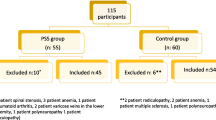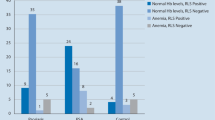Abstract
Background
Restless legs syndrome (RLS) is characterized by unpleasant sensations in the legs and an uncontrollable urge to move them in order to gain relief. Higher frequencies of RLS have been reported in systemic lupus, multiple sclerosis, rheumatoid arthritis and atopic dermatitis.
Objectives
Since the disease-related stress present in psoriasis is similar to the stress of those diseases, we aimed to study the frequency of RLS in a German cohort of patients with psoriasis.
Methods
300 patients with psoriasis and 300 healthy controls were evaluated for RLS symptoms in this study.
Results
While 17% (n = 51) of patients with psoriasis reported symptoms of RLS, only 4% (n = 12) of individuals without psoriasis suffered from RLS symptoms (95% confidence interval: 0.08–0.18, p<0.01). In patients with psoriasis and RLS the average RLS score was 16.0 ± 9.2 whereas individuals with RLS in the control group had an average RLS score of 13.5 ± 7.1.
Conclusions
Our findings indicate an increased frequency of RLS in patients with psoriasis, suggesting screening patients with psoriasis for the presence of RLS as a well-treatable co-morbidity.
Similar content being viewed by others
References
Allen RP, Picchietti D, Hening WA, Trenkwalder C, Walters AS, Montplaisi J. Restless legs syndrome: diagnostic criteria, special considerations, and epidemiology. A report from the restless legs syndrome diagnosis and epidemiology workshop at the National Institutes of Health. Sleep Med 2003; 4: 101–19.
Hogl B, Kiechl S, Willeit J, et al. Restless legs syndrome: a community-based study of prevalence, severity, and risk factors. Neurology 2005; 64: 1920–4.
Berger K, Luedemann J, Trenkwalder C, John U, Kessler C. Sex and the risk of restless legs syndrome in the general population. Arch Intern Med 2004; 164: 196–202.
Garcia-Borreguero D, Egatz R, Winkelmann J, Berger K. Epidemiology of restless legs syndrome: the current status. Sleep Med Rev 2006; 10: 153–67.
Wesstrom J, Nilsson S, Sundstrom-Poromaa I, Ulfberg J. Restless legs syndrome among women: prevalence, co-morbidity and possible relationship to menopause. Climacteric 2008; 11: 422–8.
Allen RP, Earley CJ. Restless legs syndrome: a review of clinical and pathophysiologic features. J Clin Neurophysiol 2001; 18: 128–47.
Paulus W, Dowling P, Rijsman R, Stiasny-Kolster K, Trenkwalder C, de Weerd A. Pathophysiological concepts of restless legs syndrome. Mov Disord 2007; 22: 1451–6.
Hassan N, Pineau CA, Clarke AE, Vinet E, Ng R, Bernatsky S. Systemic lupus and risk of restless legs syndrome. J Rheumatol 2011; 38: 874–6.
Manconi M, Fabbrini M, Bonanni E, et al. High prevalence of restless legs syndrome in multiple sclerosis. Eur J Neurol 2007; 14: 534–9.
Bruno E, Nicoletti A, Messina S, et al. Restless legs syndrome and multiple sclerosis: a population based case-control study in Catania, Sicily. Eur J Neurol 2015; 22: 1018–21.
Ishaq M, Sualeh Muhammad J, Hameed K. Risk of restless legs syndrome in low socioeconomic rheumatoid arthritis patients. Mod Rheumatol 2013; 23: 705–8.
Cicek D, Halisdemir N, Dertioglu SB, Berilgen MS, Ozel S, Colak C. Increased frequency of restless legs syndrome in atopic dermatitis. Clin Exp Dermatol 2012; 37: 469–76.
Ghoreschi K, Laurence A, Yang XP, Hirahara K, O’Shea JJ. T helper 17 cell heterogeneity and pathogenicity in autoimmune disease. Trends Immunol 2011; 32: 395–401.
Ghoreschi K, Weigert C, Röcken M. Immunopathogenesis and role of T cells in psoriasis. Clin Dermatol 2007; 25: 574–80.
Christophers E, Metzler G, Rocken M. Bimodal immune activation in psoriasis. Br J Dermatol 2014; 170: 59–65.
Abetz L, Allen R, Follet A, et al. Evaluating the quality of life of patients with restless legs syndrome. Clin Ther 2004; 26: 925–35.
Allen RP, Walters AS, Montplaisir J, et al. Restless legs syndrome prevalence and impact: REST general population study. Arch Intern Med 2005; 165: 1286–92.
Rapp SR, Feldman SR, Exum ML, Fleischer AB Jr., Reboussin DM. Psoriasis causes as much disability as other major medical diseases. J Am Acad Dermatol 1999; 41: 401–7.
Fredriksson T, Pettersson U. Severe psoriasis–oral therapy with a new retinoid. Dermatologica 1978; 157: 238–44.
Ghoreschi K, Thomas P, Breit S, et al. Interleukin-4 therapy of psoriasis induces Th2 responses and improves human autoimmune disease. Nat Med 2003; 9: 40–6.
Finlay AY, Khan GK. Dermatology Life Quality Index (DLQI)–a simple practical measure for routine clinical use. Clin Exp Dermatol 1994; 19: 210–6.
Walker F, Adamczyk A, Kellerer C, et al. Fumaderm® in daily practice for psoriasis–dosing, efficacy and quality of life. Br J Dermatol 2014; 171: 1197–205.
Mrowietz U, Kragballe K, Reich K, et al. Definition of treatment goals for moderate to severe psoriasis: a European consensus. Arch Dermatol Res 2011; 303: 1–10.
Walters AS, LeBrocq C, Dhar A, et al. Validation of the International Restless Legs Syndrome Stbudy Group rating scale for restless legs syndrome. Sleep Med 2003; 4: 121–32.
Winkelmann J, Wetter TC, Collado-Seidel V, et al. Clinical characteristics and frequency of the hereditary restless legs syndrome in a population of 300 patients. Sleep 2000; 23: 597–602.
Schurks M, Bussfeld P. Multiple sclerosis and restless legs syndrome: a systematic review and meta-analysis. Eur J Neurol 2013; 20: 605–15.
Taylor-Gjevre RM, Gjevre JA, Skomro R, Nair B. Restless legs syndrome in a rheumatoid arthritis patient cohort. J Clin Rheumatol 2009; 15: 12–5.
Weinstock LB, Bosworth BP, Scherl EJ, et al. Crohn’s disease is associated with restless legs syndrome. Inflamm Bowel Dis 2010; 16: 275–9.
Trenkwalder C, Paulus W, Walters AS. The restless legs syndrome. Lancet Neurol 2005; 4: 465–75.
Earley CJ. Clinical practice. Restless legs syndrome. N Engl J Med 2003; 348: 2103–9.
Ohayon MM, O’Hara R, Vitiello MV. Epidemiology of restless legs syndrome: a synthesis of the literature. Sleep Med Rev 2012; 16: 283–95.
Winkelmann J, Schormair B, Lichtner P, et al. Genome-wide association study of restless legs syndrome identifies common variants in three genomic regions. Nat Genet 2007; 39: 1000–6.
Yeh P, Walters AS, Tsuang JW. Restless legs syndrome: a comprehensive overview on its epidemiology, risk factors, and treatment. Sleep Breath 2012; 16: 987–1007.
Mattei PL, Corey KC, Kimball AB. Psoriasis Area Severity Index (PASI) and the Dermatology Life Quality Index (DLQI): the correlation between disease severity and psychological burden in patients treated with biological therapies. J Eur Acad Dermatol Venereol 2014; 28: 333–7.
Berger K, Kurth T. RLS epidemiology–frequencies, risk factors and methods in population studies. Mov Disord 2007; 22(Suppl 18): 420–3.
Miller IM, Ellervik C, Yazdanyar S, Jemec GB. Meta-analysis of psoriasis, cardiovascular disease, and associated risk factors. J Am Acad Dermatol 2013; 69: 1014–24.
LaRochelle JS, Karp BI. Restless legs syndrome due to interferonalpha. Mov Disord 2004; 19: 730–1.
Taylor-Gjevre RM, Gjevre JA, Nair BV, Skomro RP, Lim HJ. Improved Sleep Efficiency after Anti-Tumor Necrosis Factor alpha Therapy in Rheumatoid Arthritis Patients. Ther Adv Musculoskelet Dis 2011; 3: 227–33.
Belge K, Brück J, Ghoreschi K. Advances in treating psoriasis. F1000prime reports 2014; 6: 4.
Ghoreschi K, Gadina M. Jackpot! new small molecules in autoimmune and inflammatory diseases. Exp Dermatol 2014; 23: 7–11.
Ghoreschi K, Brück J, Kellerer C, et al. Fumarates improve psoriasis and multiple sclerosis by inducing type II dendritic cells. J Exp Med 2011; 208: 2291–303.
Author information
Authors and Affiliations
Corresponding author
About this article
Cite this article
Schell, C., Schleich, R., Walker, F. et al. Restless legs syndrome in psoriasis: an unexpected comorbidity. Eur J Dermatol 25, 255–260 (2015). https://doi.org/10.1684/ejd.2015.2525
Accepted:
Published:
Issue Date:
DOI: https://doi.org/10.1684/ejd.2015.2525




